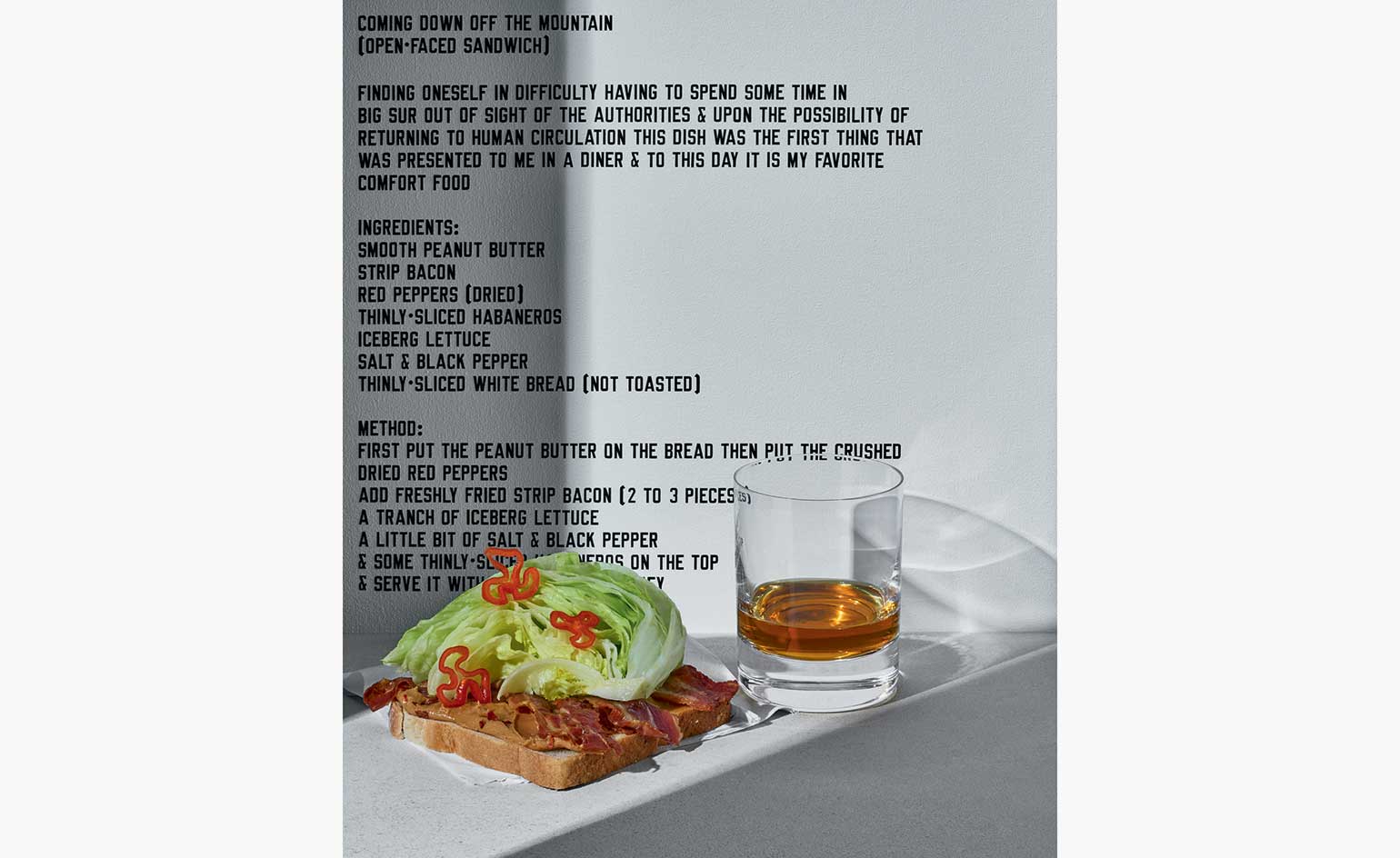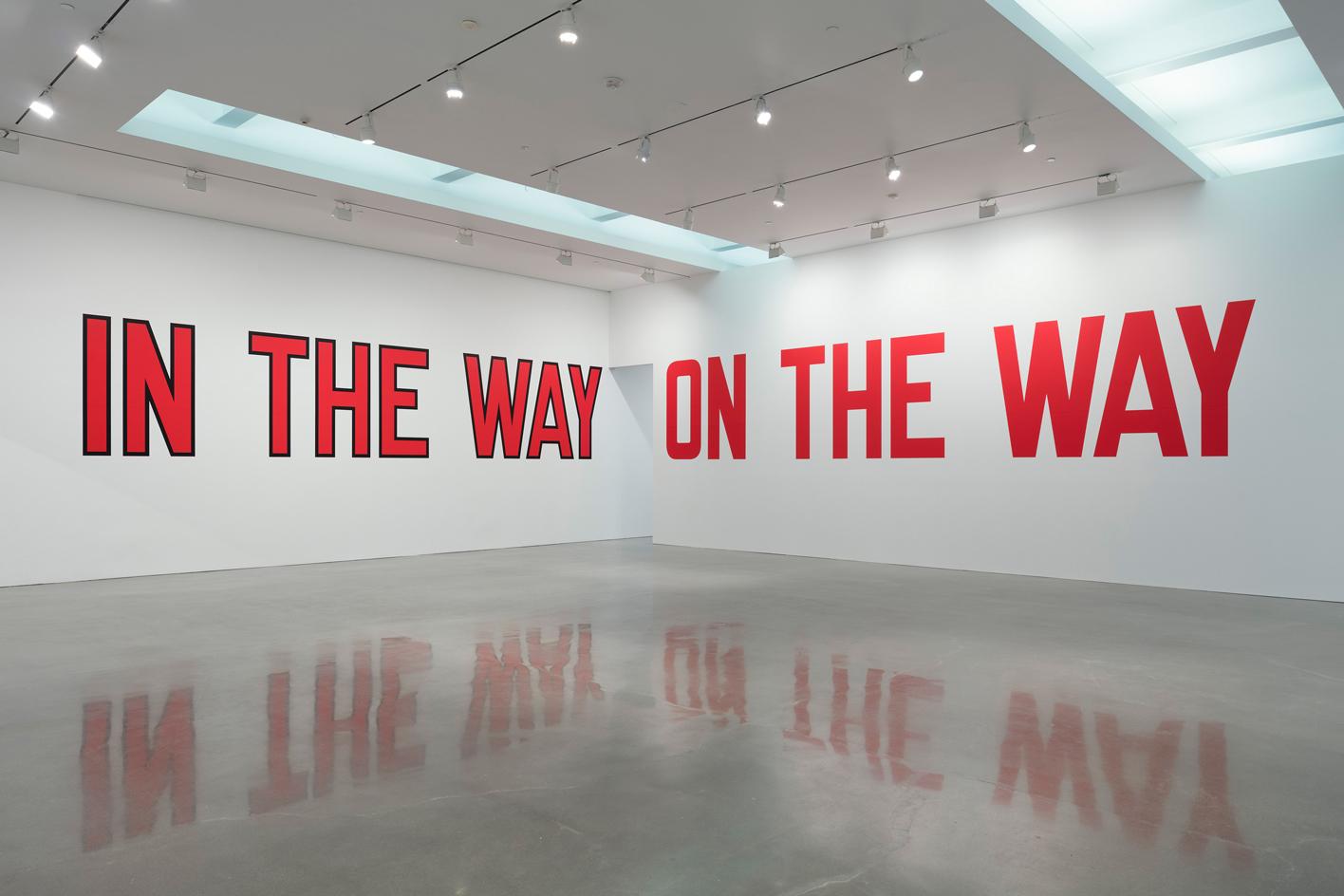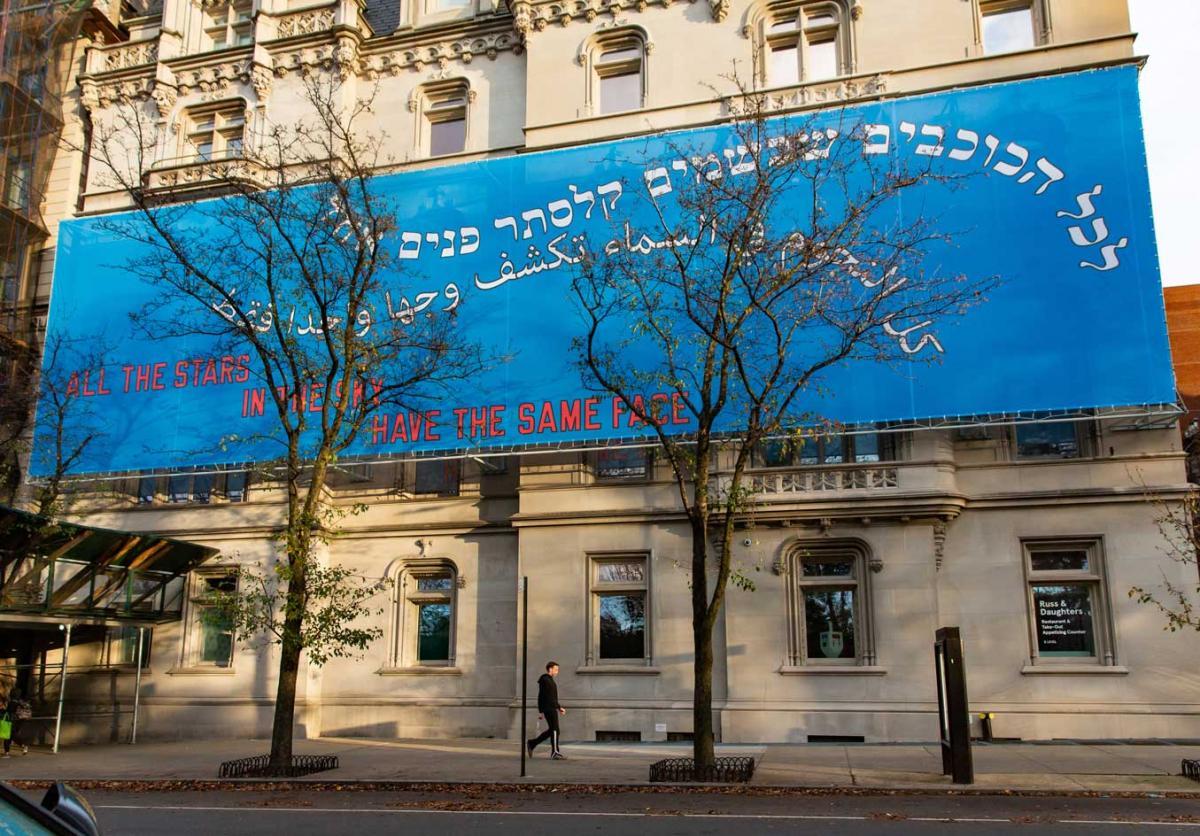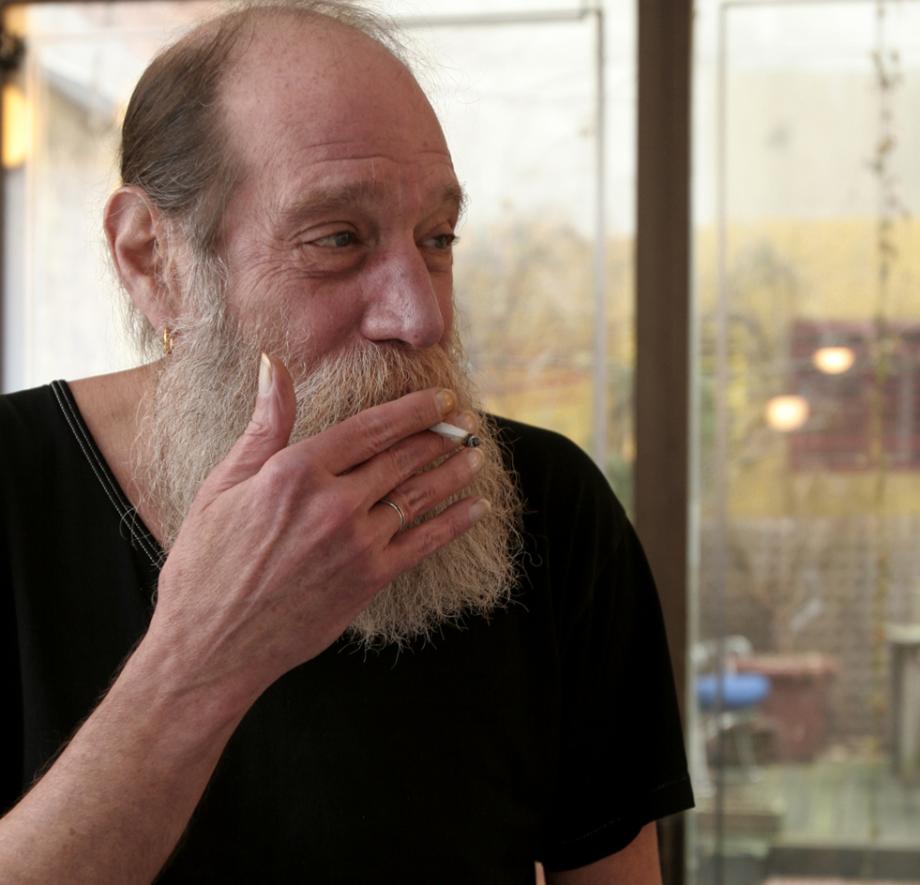Remembering Lawrence Weiner (1942–2021)
We pay tribute to American conceptual art pioneer Lawrence Weiner – known for his philosophical heft, linguistic dexterity and political candour – who has passed away aged 79

Lawrence Weiner was born in The Bronx, New York in 1942, where his parents owned a sweet shop. After graduating high school, he worked in manual industrial jobs: on oil tankers and railroad cars, but then he saw a Jackson Pollock at MoMA, and everything changed.
Returning to New York after a trip across North America, Weiner found Abstract Expressionism at its climax, and he was captivated. Much to his parents’ concern, he began to pursue art. He presented his first work publicly at 19. Titled Cratering Piece, and involving four explosives and a field in Marin County, California, it announced a far from timid arrival on the scene.
For six years in the 1960s, he orchestrated a series of explosions in the California landscape to create craters as individual sculptures. Around the same time, he began writing instructive statements describing creative gestures: ‘Two minutes of spray paint directly on the floor...’ or ‘A 36" x 36" removal of lathing or support wall…’ (both 1968). It wasn’t entirely clear whether the statement was attached to an artwork, or whether the statement was the artwork. And that was the point.

Lawrence Weiner, PLACED ON THE TIP OF A WAVE, 2009, Language + the materials referred to Dimensions variable.
In 1968, Weiner wrote his ‘declaration of intent’:
‘The artist may construct the piece.
The piece may be fabricated.
The piece need not be built.
Receive our daily digest of inspiration, escapism and design stories from around the world direct to your inbox.
Each being equal and consistent with the intent of the artist, the decision as to condition rests with the receiver upon the occasion of receivership.’
This manifesto, published in his first book, Statements, turned the conventional artist-viewer relationship upside down. It was now the viewer’s responsibility to realise the work, the artist’s role was to facilitate this realisation. The book contained only verbal descriptions of sculptures’ materials and their relationships to space, shifting the mental heavy-lifting onto the observer. Through his modest 64-page paperback (now considered one of the seminal conceptual literary works), Weiner realised that his art could exist in language alone.
Weiner was present at the birth of conceptualism in the late 1960s. Shaking up conventions, he probed the essence of what art should stand for, what role the artist should assume, and how they should relate to the viewer.
RELATED STORY


Installation view of Lawrence Weiner, ’ON VIEW’, Regen Projects, Los Angeles, February 27 – June 20, 2020.
As Weiner’s ideas evolved, he moved away from describing metaphysical sculptures, and instead turned words themselves into sculptures. Through fragments of conversations, poetry and prose, he created graphically-rendered cryptic compositions, often laden with black humour, double meanings and wordplay.
He found words to be a versatile medium. He presented his work in galleries, in books, as audio, but most notably, in public spaces: as graffiti, on manhole covers, on billboards, and exterior walls. Sharp, poetic and rendered in his unmistakable caps-locked typeface, Margaret Seaworthy Gothic, Weiner’s work was always succinct, and always expressive. He is best known for To See and Be Seen (1972), Motion Enough to Bring About…(2008), and All The Stars In The Sky Have The Same Face (2011/21). The latter was recently installed on the façade of the Jewish Museum, New York, a commentary on the poignant history of Jewish self-isolation in response to anti-Semitism.

Installation view of Lawrence Weiner, All The Stars In The Sky Have The Same Face, 2011/2020, The Jewish Museum, NY.
From 2007–8, the artist was given major retrospective surveys at the Museum of Contemporary Art, Los Angeles (MOCA) and the Whitney Museum of American Art, New York.
Other major international solo exhibitions were held at the Stedelijk Museum, Amsterdam (1988/89), Hirshhorn Museum and Sculpture Garden, Washington, DC (1990), Institute of Contemporary Arts, London (1991), Musée d’Art Contemporain, Bordeaux (1991/92), Museo Tamayo Arte Contemporáneo, Mexico City (2004), San Francisco Museum of Modern Art (1992), The Jewish Museum, New York (2012) and Blenheim Palace, Oxfordshire (2015).
Weiner was a true anti-establishment creator. He shared his work liberally with the masses, and always left enough room for viewers to cultivate their own interpretations.
He posed questions without using question marks. He used text to interrogate, rather than explain. It wasn’t just what things meant, but how things meant. Our debt to him goes far beyond words.

Portrait of artist Lawrence Weiner, who has passed away aged 79.

Installation view of Lawrence Weiner ’AROUND & AROUND HIGH & LOW’, Regen Projects, Los Angeles. May 19– June 23, 2012.
Harriet Lloyd-Smith was the Arts Editor of Wallpaper*, responsible for the art pages across digital and print, including profiles, exhibition reviews, and contemporary art collaborations. She started at Wallpaper* in 2017 and has written for leading contemporary art publications, auction houses and arts charities, and lectured on review writing and art journalism. When she’s not writing about art, she’s making her own.
-
 Men’s Fashion Week A/W 2026 is almost here. Here’s what to expect
Men’s Fashion Week A/W 2026 is almost here. Here’s what to expectFrom this season’s roster of Pitti Uomo guest designers to Jonathan Anderson’s sophomore men’s collection at Dior – as well as Véronique Nichanian’s Hermès swansong – everything to look out for at Men’s Fashion Week A/W 2026
-
 The international design fairs shaping 2026
The international design fairs shaping 2026Passports at the ready as Wallpaper* maps out the year’s best design fairs, from established fixtures to new arrivals.
-
 The eight hotly awaited art-venue openings we are most looking forward to in 2026
The eight hotly awaited art-venue openings we are most looking forward to in 2026With major new institutions gearing up to open their doors, it is set to be a big year in the art world. Here is what to look out for
-
 Out of office: The Wallpaper* editors’ picks of the week
Out of office: The Wallpaper* editors’ picks of the week'Tis the season for eating and drinking, and the Wallpaper* team embraced it wholeheartedly this week. Elsewhere: the best spot in Milan for clothing repairs and outdoor swimming in December
-
 Nadia Lee Cohen distils a distant American memory into an unflinching new photo book
Nadia Lee Cohen distils a distant American memory into an unflinching new photo book‘Holy Ohio’ documents the British photographer and filmmaker’s personal journey as she reconnects with distant family and her earliest American memories
-
 Out of office: The Wallpaper* editors’ picks of the week
Out of office: The Wallpaper* editors’ picks of the weekIt’s been a week of escapism: daydreams of Ghana sparked by lively local projects, glimpses of Tokyo on nostalgic film rolls, and a charming foray into the heart of Christmas as the festive season kicks off in earnest
-
 Ed Ruscha’s foray into chocolate is sweet, smart and very American
Ed Ruscha’s foray into chocolate is sweet, smart and very AmericanArt and chocolate combine deliciously in ‘Made in California’, a project from the artist with andSons Chocolatiers
-
 Inside the work of photographer Seydou Keïta, who captured portraits across West Africa
Inside the work of photographer Seydou Keïta, who captured portraits across West Africa‘Seydou Keïta: A Tactile Lens’, an exhibition at the Brooklyn Museum, New York, celebrates the 20th-century photographer
-
 Out of office: The Wallpaper* editors’ picks of the week
Out of office: The Wallpaper* editors’ picks of the weekFrom sumo wrestling to Singaporean fare, medieval manuscripts to magnetic exhibitions, the Wallpaper* team have traversed the length and breadth of culture in the capital this week
-
 María Berrío creates fantastical worlds from Japanese-paper collages in New York
María Berrío creates fantastical worlds from Japanese-paper collages in New YorkNew York-based Colombian artist María Berrío explores a love of folklore and myth in delicate and colourful works on paper
-
 Out of office: the Wallpaper* editors’ picks of the week
Out of office: the Wallpaper* editors’ picks of the weekAs we approach Frieze, our editors have been trawling the capital's galleries. Elsewhere: a 'Wineglass' marathon, a must-see film, and a visit to a science museum